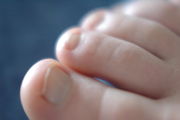Hallux
| File:Wiktionary-logo-en-v2.svg | Look up big toe in Wiktionary, the free dictionary. |
Editor-In-Chief: C. Michael Gibson, M.S., M.D. [1]
Overview

The hallux pl. halluces, also known as the big toe or "thumb toe" is the innermost toe of the foot, counted as digit I.
In humans, the hallux is longer than the second or pointer toe for a majority of people. This is an inherited trait in humans, where the dominant gene causes the normal length hallux while the homozygous recessive geneotype presents with a longer second toe. (Commonly known as "mitten foot").
Diseases
People with the rare genetic disease fibrodysplasia ossificans progressiva characteristically have short big toes.
The big toe is the most common focus of gout and Ingrown nail attacks.
See also
eo:Halukso hi:पादांगुष्ठ io:Haluxo it:Alluce la:Hallux